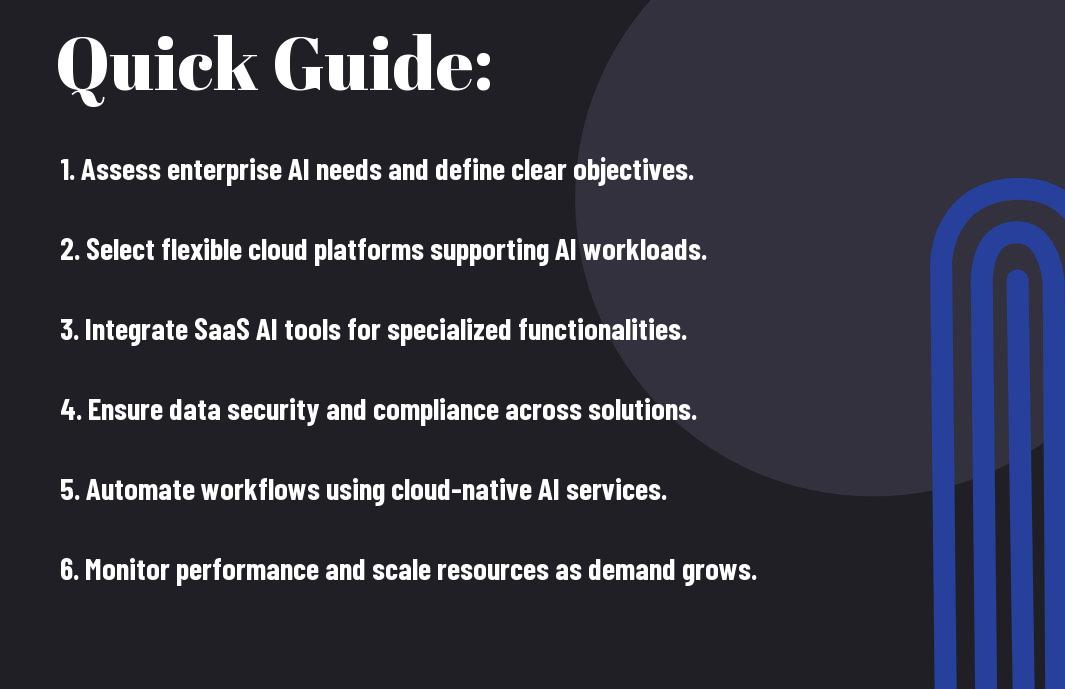Cloud technology opens the door to efficient, flexible, and cost-effective AI solutions for your enterprise. By embracing Software as a Service (SaaS) offerings, you can rapidly scale your AI initiatives without heavy infrastructure investments. This guide will walk you through the vital steps to effectively deploy AI within your organization, ensuring you can harness the full potential of cloud and SaaS to improve your operational efficiency and innovation capability. Elevate your business with strategic cloud solutions tailored to support your specific AI needs, and propel your organization into the future.
Key Takeaways:
- Utilize cloud infrastructure to ensure flexibility and scalability, allowing enterprises to adjust resources according to demand without significant upfront investments.
- Adopt SaaS solutions for easier deployment and integration, enabling teams to access the latest tools and updates without the burden of maintenance.
- Focus on data management and governance in the cloud environment to optimize AI model performance and ensure compliance with regulatory standards.
Cloud Infrastructure: The Backbone of AI Scalability
Your enterprise’s ability to scale AI solutions efficiently relies heavily on robust cloud infrastructure. This foundation supports the flexibility needed for dynamic workloads and rapid changes inherent in AI applications. With the demand for data processing power surging, you can leverage cloud providers that offer tailored resource allocation and high-performance computing. Implementing a cloud infrastructure not only accelerates deployment but also enables your teams to focus on innovation by minimizing the management of physical servers. Discover more on How to Use AI for SaaS: Use Cases & Best Practices.
Building a Resilient Architecture
A resilient architecture is key for maintaining uptime and reliability in AI implementations. You should consider multi-cloud strategies to prevent single points of failure, ensuring that your applications remain operational even during outages. Additionally, adopting containerization and microservices allows for modular deployments that simplify updates and maintenance, reducing the risk of disruptions.
Optimizing Cost Efficiency with Cloud Solutions
Maximizing cost efficiency in AI infrastructure is achievable through thoughtful cloud service selection and management. By leveraging pay-as-you-go pricing models, your enterprise can scale resources up or down according to fluctuating needs without incurring unnecessary expenses. Additionally, automating workloads and utilizing serverless architectures can further contribute to significant savings.
Focusing on cost efficiency allows you to allocate funds more strategically towards innovation and development rather than on maintaining hardware. Transitioning to cloud solutions means not only lower upfront costs but also reduced complexity in cost management. Tools and analytics offered by cloud providers help you monitor usage patterns, enabling smarter decisions about resource allocation while ensuring your AI systems perform optimally without overspending. This approach not only alleviates financial pressure but also fosters agile growth by making funds available for other critical areas of your business.

Selecting the Right SaaS Tools: Beyond the Basics
Moving beyond the initial checklist of features, selecting the right SaaS tools necessitates a deeper probe their practical applications for your enterprise AI needs. Features like scalability, integration capabilities with existing systems, and customizable workflows can significantly enhance operational efficiency. It’s wise to examine how these tools can manage large volumes of data and adapt to evolving demands without causing disruptions.
Features That Enhance AI Capabilities
Look for SaaS solutions that provide advanced analytics, machine learning frameworks, and robust APIs for seamless integration. Features such as automated feedback loops, data visualization dashboards, and collaborative tools will not only enhance your AI capabilities but also drive user engagement and productivity across your organization.
Evaluating Vendor Reliability and Support
Vendor reliability and support can make or break your SaaS implementation. Quality of service, response times, and availability of dedicated support teams are key elements to examine before making your choice. You should also assess the vendor’s track record in maintaining service uptime and promptly addressing security concerns.
Researching vendor reliability involves looking at customer reviews, case studies, and industry recognition. Companies like Gartner and Forrester consistently evaluate SaaS providers, offering insights into their performance and customer satisfaction. Furthermore, inquire about the type of support provided—24/7 service can be particularly important for mission-critical applications. Engaging with the vendor’s existing customers can give you real-world insights into the level of support you can expect, ensuring you have a partner who will grow alongside your AI initiatives.

Data Management Strategies for Robust AI Insights
Effective data management strategies ensure that your AI initiatives yield actionable insights. By adopting a structured approach to data collection, cleaning, and retrieval, your organization can improve the quality of inputs for AI models. Methodologies such as data versioning and the use of metadata facilitate better tracking of data lineage and origin, which enhances the overall robustness of your AI solutions.
Leveraging Cloud Storage for Data Accessibility
Cloud storage solutions provide unparalleled accessibility to data, allowing your team to access vast data sets from anywhere at any time. With options like Amazon S3 or Google Cloud Storage, you can scale your storage needs up or down seamlessly, reducing the costs associated with physical data centers. This flexibility ensures that your AI models can easily retrieve and utilize the data they need to function optimally.
Ensuring Data Security and Compliance
With the rise in cloud adoption, securing your data and ensuring compliance with regulations such as GDPR or HIPAA has become paramount. Implementing end-to-end encryption, regular audit trails, and access controls can mitigate the risks associated with data breaches. Additionally, cloud service providers often offer built-in compliance tools, simplifying the process of adhering to industry standards.
Staying updated with evolving privacy regulations is also vital. For example, enforcing strict access controls ensures that only authorized users can view or manipulate sensitive data, while regular training for your employees on security best practices can drastically reduce human error incidents. Furthermore, integrating automated compliance monitoring tools allows you to maintain a continuous check on your data practices, streamlining adherence to ever-changing legal frameworks. By establishing a strong security posture through the combination of technology and employee training, you protect your enterprise AI investments effectively.
Integrating AI Workflows into SaaS Platforms
Integrating AI workflows into your existing SaaS platforms allows for seamless data exchange and process automation, leading to significant operational efficiencies. By embedding AI capabilities directly into your SaaS solutions, you can enhance analytical capacities and gain insights quicker, reducing the time spent on manual tasks. For instance, implementing natural language processing (NLP) tools within customer relationship management (CRM) systems can help you analyze customer interactions and sentiment in real time, optimizing your response strategies.
Streamlining Processes for Enhanced Collaboration
Streamlining processes through AI integration not only boosts individual productivity but also fosters enhanced collaboration across teams. By automating repetitive tasks and equipping team members with visual analytics tools, you facilitate better communication and knowledge sharing. For example, deploying AI-driven dashboards that aggregate data from various departments helps employees understand project statuses and performance indicators, paving the way for improved decision-making and teamwork.
Aligning AI Models with Business Objectives
Aligning your AI models with your specific business objectives ensures your technology investments yield meaningful results. By understanding key performance indicators (KPIs) relevant to your goals, you can train your AI systems to target those metrics effectively. For instance, if improving customer acquisition is a primary objective, your AI models should be focused on predictive analytics that identify high-probability leads and recommend personalized marketing strategies that resonate with your target audience.
When your AI models are tailored to align with business objectives, they become instrumental in driving growth. This may involve refining data selection processes to prioritize information that directly impacts sales or customer satisfaction. Additionally, regular assessments of AI performance against established KPIs allow you to pivot strategies based on real-time feedback, optimizing resource allocation and ensuring that your AI initiatives directly support organizational goals. With this alignment, your AI tools become powerful allies in navigating the complexities of market demands and customer expectations.
Measuring Success: Key Performance Indicators for AI Initiatives
Establishing clear metrics is imperative for evaluating the impact of your AI initiatives. By focusing on Key Performance Indicators (KPIs), you can systematically assess whether your projects deliver the expected outcomes. Common KPIs include accuracy rates, cost savings, and customer satisfaction scores. Tailor these metrics to suit your specific business goals and align them with your broader organizational strategy. For deeper insights into how AI integrates with SaaS, explore AI in SaaS: Benefits, applications, implementation and ….
Defining Metrics that Matter
Identifying the right metrics to assess your AI initiatives ensures you focus on outcomes that impact your business. Start by establishing your primary objectives, whether it’s improving operational efficiency, enhancing customer engagement, or driving revenue growth. Use metrics such as return on investment (ROI) and time to market to quantify progress. By engaging stakeholders, particularly those from business units, you can align your KPIs more closely with real-world applications.
Iterating and Adapting Based on Performance Data
Successful AI implementation requires a dynamic approach to performance monitoring. Regularly analyzing performance data allows you to identify trends, assess effectiveness, and make adjustments as necessary. For instance, if certain algorithms are underperforming, you can recalibrate or replace them based on data insights. Frequent reviews enable you to remain agile, ensuring your AI projects continue to meet evolving expectations and objectives.
Incorporating an iterative process into your AI strategy not only enhances performance but also fosters innovation. By creating feedback loops, you can bring together analysis of failed initiatives to understand what works best. Emphasizing continuous learning will lead to a more predictive rather than reactive approach, positioning your enterprise to capitalize on new opportunities swiftly. Utilizing performance data in this manner can significantly elevate your AI initiatives, driving long-term success.
To wrap up
Summing up, effectively leveraging cloud and SaaS solutions can transform your enterprise AI implementation, allowing for scalable growth and enhanced operational efficiency. By understanding the unique offerings of these platforms, you can optimize your workflows and better serve your organization’s needs. Explore insights on Leveraging SaaS AI Tools To Improve Workflows: 9 Tips For … to harness the full potential of these technologies and stay ahead in the competitive landscape.
FAQ
Q: What are cloud and SaaS solutions, and how do they facilitate AI implementation for enterprises?
A: Cloud and SaaS (Software as a Service) solutions provide scalable resources and software applications over the internet, which facilitate AI implementation by allowing enterprises to access powerful computing capabilities without the need for substantial on-premises infrastructure. These solutions enable organizations to quickly deploy AI models, access specialized tools and frameworks, and easily scale their resources based on demand, all while minimizing upfront costs and maintenance efforts.
Q: How can enterprises ensure data security when leveraging cloud and SaaS for AI projects?
A: Enterprises can maintain data security while utilizing cloud and SaaS solutions for AI by selecting providers that comply with industry standards and regulations, such as GDPR or HIPAA. Additionally, implementing encryption for data at rest and in transit, utilizing identity and access management systems, and regularly conducting security audits can further enhance data protection. It’s also necessary to stay informed about the provider’s security measures and maintain a clear data governance policy.
Q: What are the best practices for integrating cloud and SaaS solutions into an existing AI strategy?
A: To effectively integrate cloud and SaaS solutions into an existing AI strategy, enterprises should start by defining clear objectives that align with their business goals. Next, conducting a thorough evaluation of available platforms to choose the right tools that match their requirements is important. Establishing an agile workflow that promotes continuous experimentation and feedback will help refine AI models effectively. It’s also beneficial to invest in training programs for staff to enhance their skills in these technologies, ensuring a smoother transition and maximizing the benefits of these solutions.







